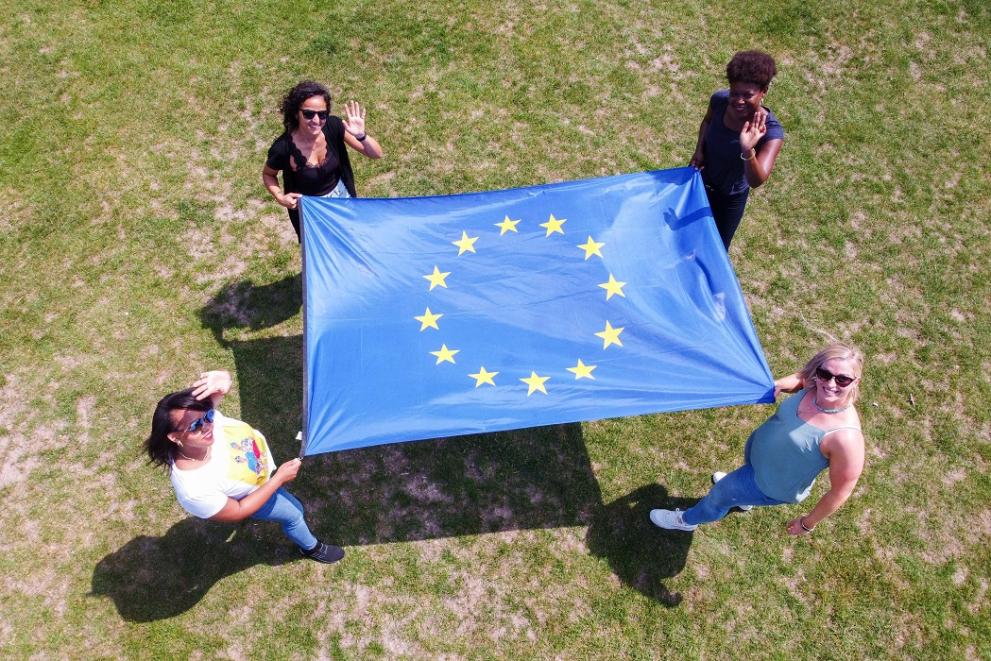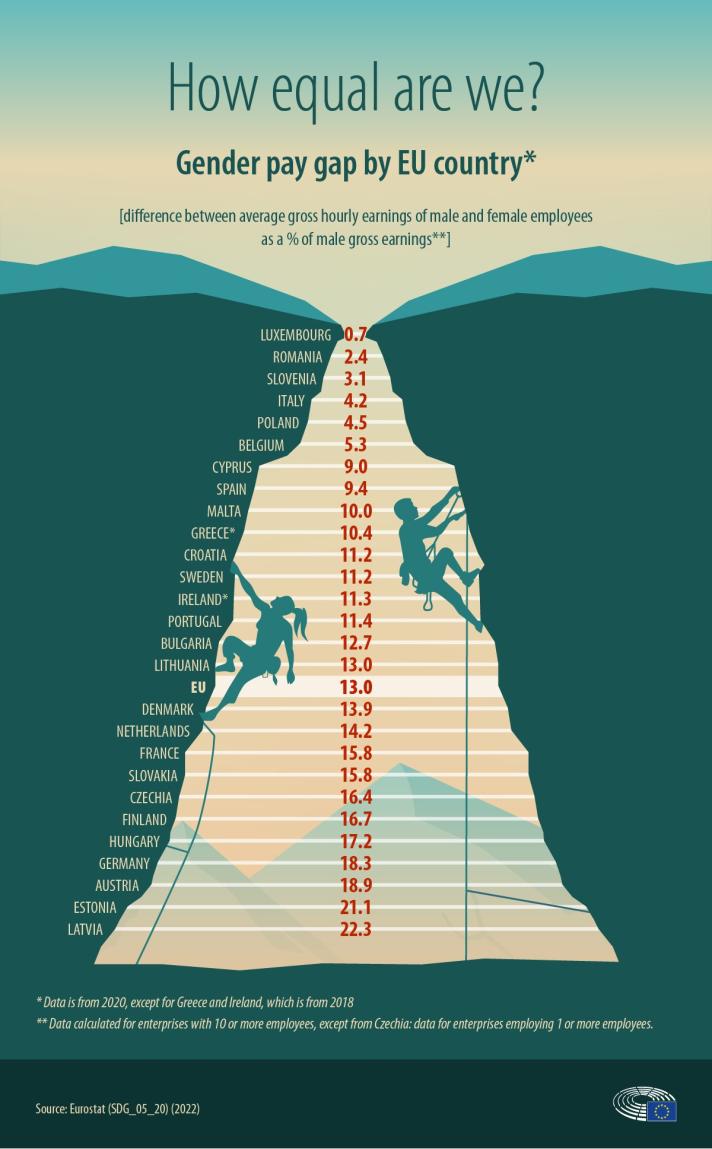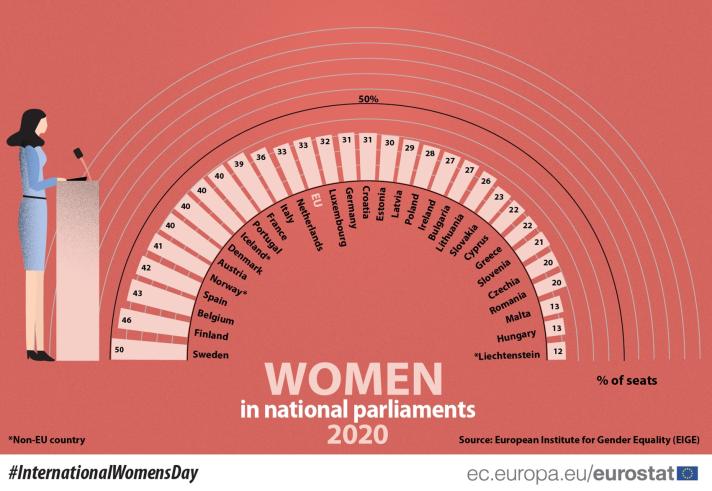
Irish women have more rights today than their mothers, grandmothers and great grandmothers ever had, but while significant progress on gender equality has been made, inequalities still exist.
Across Europe women are still over-represented in lower paid jobs, under-represented in decision-making positions of power and suffer disproportionally from gender-based violence.
Equality between genders is one of the fundamental principles of EU law, and legislation for equal rights between women and men has existed since the very early days of the European Community.
The European Union is the driving force behind several pieces of important Irish legislation that have improved areas like equal treatment when applying for a job, equal treatment at work, protection of pregnant workers, protection of breastfeeding mothers and rights to maternity and parental leave.
The gender perspective is integrated into all EU policies through gender mainstreaming, meaning the interests and concerns of both women and men are considered at all stages of strategic planning.
However, many challenges remain and the European Commission’s Gender Equality Strategy 2020-2025 is helping Ireland move ever closer towards achieving its goal of being a nation of equals.
Gender Equality in Ireland

Irish gender equality legislation was first introduced in the 1970s after Ireland became a member of what was then the European Economic Community (EEC).
One of the first benefits was that more women were able to access the labour market thanks to the abolition of an outdated marriage bar for women in public service jobs.
Ireland adopted gender mainstreaming as a principle during the late 1990s and early 2000s and a European Commission requirement means that Irish projects supported by EU funds have to promote equal opportunities. The Irish government has extended this requirement to cover all State funded projects.
Gender equality across the EU is measured by the Gender Equality Index, a tool published by the European Institute for Gender Equality (EIGE).
The Index uses a points system to measure equality progress under various topics, with 100 representing full equality. The 2023 edition shows an EU overall tally of 70.2 points out of 100, compared to 68.6 in 2022, the biggest annual jump in the overall score since the first edition of the Index in 2013.
Ireland’s 2023 index score is above the EU average with 73 points, ranking the country 9th overall in the EU, down from 7th place in 2022. The Irish score shows gender inequalities are most pronounced in the domains of time (59.5) with Irish women spending far more time on care and domestic activities and less on social activities than Irish men. Ireland’s second lowest score was in the area of power, where the points tally is 64.7.
Despite this, significant improvement has still been made in Ireland’s power domain, and the country’s score has increased by 27.5 points since 2013. But Ireland needs to improve when it comes to political decision-making, where the country scores just 50.6 points and ranks 18th in the EU.
Ireland scores well when it comes to tackling inequality in health (94.8 points), ranking first in the EU, and ranking 6th when it comes to money (88 points).
Employment and education
The Commission’s Gender Equality Strategy aims to improve employment prospects for women through promoting equal economic independence, closing the gender pay gap and advancing gender balance in decision making.
Employment rates in the EU are systematically higher for men than women, with 78.5% of men employed compared to 67.7% of women in 2021.
Despite more women graduating from universities than men, they aren’t getting the same job opportunities and women’s work-life balance is often poorer than men’s.
The burden of responsibilities outside of employment also still rests largely on the backs of women, who disproportionally carry out most of the unpaid domestic and caregiving work.
An EU directive, which came into effect in August 2022, aims to address work-life balance issues through new rules that set out minimum standards for paternity, parental and carers' leave.
The directive also establishes additional rights, such as the right to request flexible working arrangements, which will help people develop their careers and family life without having to sacrifice either.
More Irish women now go on to third level education, according to figures from Ireland’s Central Statistics Office (CSO). In 2021, a total of 61% of all Irish adults aged 30-34 had participated in third level education and 66% were women. Females aged 18-24 were also less likely to be early school leavers (2%) compared to males (4%).
However, it’s a different story for women when they finish their education. The average gender pay gap in the EU stood at 13% in 2020 while the latest available figure for Ireland, which dates back to 2018, is 11.3%.

Key actions
- The Gender Equality Strategy 2020-2025 presents policy objectives and actions to make significant progress by 2025 towards a gender-equal Europe.
- Under EU legislation, Member States must eliminate discrimination on grounds of sex with regard to all aspects and conditions of payment for the same work or for work of equal value.
- The Commission's directive on adequate minimum wages for workers supports gender equality by helping to close the gender pay gap as more women than men earn minimum wages in Europe.
- The European Commission's proposals on pay transparency to ensure that women and men in the EU get equal pay for equal work will soon become EU law. Legislation requiring companies in Ireland to report regularly on gender pay gaps was introduced in 2022.
- In September 2022, the Commission presented the European Care Strategy to ensure affordable and accessible quality care services across the EU. This will enable more women caregivers to continue with their careers.
- Gender equality progress in Member States is monitored through the European Semester, particularly when it comes to the labour market, social inclusion and education.
- Women as investors and entrepreneurs are supported through Horizon Europe's European Innovation Council and through the InvestEU programme.
Gender-based violence
Women in Ireland, across the EU and indeed the world continue to be targets of gender-based violence, stereotyping and hate speech.
In recent years more and more women have also become victims of cyberstalking, online harassment and threats, as well as the sharing of private data and intimate images.
Women are also disproportionately affected by harassment at work, where unequal power relations, low pay, precarious working conditions and stereotyping often leaves them vulnerable to abuse.
Spikes in domestic violence and abuse reports during Covid-19 lockdowns, when victims were trapped at home with their abusers, were a sad reminder that women frequently face the most danger from people they know.
Data published in 2021 by the European Union Agency for Fundamental Rights (FRA) shows that violence against women is systematically under-reported and commonly features coercive control and attacks of a sexual nature.
The European Institute for Gender Equality (EIGE) estimates the cost of gender-based violence across the EU to be €366 billion per year, with the costs of violence against women amounting to €289 billion (79%). The cost of domestic and intimate partner violence - of which 87% is carried out against women - is estimated to be €175 billion.
A European Parliament Research Service (EPRS) study in 2021 estimated the overall costs of cyber harassment and cyber stalking against women at between €49 and €89.3 billion.
Human trafficking for sexual exploitation is another form gender-based violence and it is often rooted in poverty and inequality. Over 70% of all human trafficking victims in the EU and 92% of victims trafficked for sexual exploitation are women and girls.
Women are also victims of femicide, forced marriages, and Female Genital Mutilation (FGM). It’s estimated that there are at least 600,000 women living in the EU who have undergone Female Genital Mutilation (FGM).
The European Commission’s Gender Equality Strategy is tackling gender-based violence through ambitious measures aimed at supporting and protecting victims, and holding perpetrators accountable.
Key actions:
- The European Commission has proposed new EU-wide rules to stop violence against women and domestic violence. The proposal aims to ensure a minimum level of protection against such violence, regardless of whether it takes place online or offline.
- Accession of the EU to the Council of Europe’s Istanbul Convention, which recognises violence against women as a violation of human rights and a form of discrimination against women, is due to be finalised, and if that’s not possible, the Commission will propose measures to achieve the same objectives.
- The Commission supports awareness raising on workplace harassment and gender bias through the EU strategic framework on health and safety at work.
- The Digital Services and Digital Markets Acts protect the fundamental rights of users of the digital space, and so contribute to making the internet safer for women.
- The EU Strategy on victims’ rights aims to ensure that all victims of all crime, including gender-based violence, can fully rely on their rights.
- Eurostat is working on an EU survey on gender-based violence, to be carried out by national statistical institutes with results expected in 2023. Accurate data on the problem is key to developing efficient and effective policy and legal responses and to assess trends and progress.
- The Commission finances projects to prevent and combat gender-based violence through the Rights, Equality and Citizenship programme.
Cost of gender-based violence in the EU
EU-wide rules to stop violence against women and domestic violence
Women in power
Women are still significantly under-represented in decision-making positions in all fields across the EU, with only a minority making it to the highest positions in political, economic and social institutions.
The EIGE Gender Equality Index for 2022 shows that Ireland still has work to do to ensure women have equality when it comes to positions of power.
Progress has been made and Ireland’s index score has increased by 28.6 points since 2005, but it’s still just 61.7 points out of a possible 100, although that’s higher than the EU average of 57.2.
Ireland has a legislative female election candidate quota of 30% to support an increase of women in parliament. The General Election in February 2020 saw 36 women (22.5%) elected out of a total of 160 TDs in Dáil Éireann. However, that’s still below the EU average of 33% of seats in national parliaments in 2022.

According to the EIGE 2022 index, equality in economic power in Ireland has increased substantially since 2010 from 21.7 points to 62.9. Women now make up 33.2% of board members in Ireland’s largest quoted companies, supervisory boards and board of directors.
The share of women board members of Ireland’s Central Bank stands at 40%, compared to an average of just 26.4% in central banks across the EU.
Ireland also performs well when it comes to equality in social power, which includes decision-making in research-funding and media. Half of the board members of publicly owned broadcasting organisations are women while the figure for research-funding organisations is 45.5%.
The European Commission has instigated legislation and taken actions aimed at ensuring women are better represented in positions of power.
Key actions:
- Political agreement was reached in 2022 for the adoption of a European Commission proposal for a Directive on improving the gender balance on corporate boards, which sets the aim of a minimum of 40% of female non-executive members on company boards.
- The Commission has proposed revised rules on the funding of European political parties which includes measures that requires them to provide evidence on gender representation when applying for EU funding.
- The Commission monitors the situation on women and men in decision-making positions through its annual report on equality between women and men.
- As an employer, the European Commission is committed to reaching gender parity for all its own management levels. In December 2019, the share of women in senior management was 36.6% while the figure for middle management was 45.5%. By 1 January 2022, those figures had increased to 43.3% and 45.7%.
- The European Commission and the High Representative for Foreign and Security Policy have jointly adopted the Gender action plan III for 2021-2025, which sets out an ambitious agenda for gender equality and women’s empowerment in all EU external actions.
EU action to promote gender balance in decision-making
